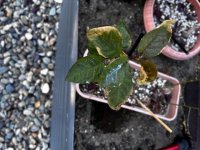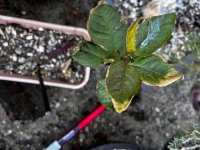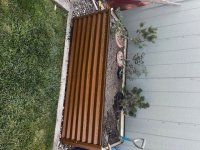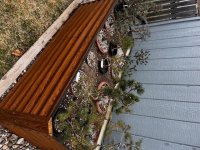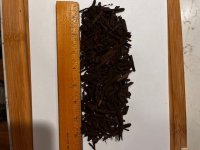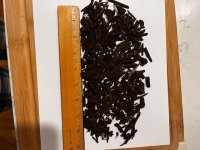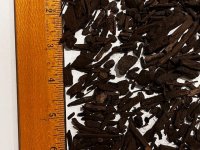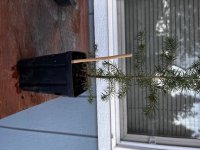This are seedling cherry. I have a number of them and some of them have this on the leaves. I have removed the leaves affected, sprayed with several kinds of fungicide but it keeps coming back. I have also experienced where the leaves seem to wither but remain green, and finally just wither away and fall off. Help appreciated. TY
You are using an out of date browser. It may not display this or other websites correctly.
You should upgrade or use an alternative browser.
You should upgrade or use an alternative browser.
Help with disease ID pls
- Thread starter August44
- Start date
Wires_Guy_wires
Imperial Masterpiece
Looks like nutrient burn.
Thanks for the reply. What is nutrient burn?Looks like nutrient burn.
Wires_Guy_wires
Imperial Masterpiece
Too many salts in the soil from nutrients, or from high salt content of the water.
That tends to burn the outer edges of the foliage with all kinds of symptoms. But if the outer tips go brown or orange, that's always the first thing to investigate.
That tends to burn the outer edges of the foliage with all kinds of symptoms. But if the outer tips go brown or orange, that's always the first thing to investigate.
Hmmm. Interesting, I will check that possibility out. Can we get salts from fertilizer or other things we feed these trees? Our water is not salty. Thanks WiresToo many salts in the soil from nutrients, or from high salt content of the water.
That tends to burn the outer edges of the foliage with all kinds of symptoms. But if the outer tips go brown or orange, that's always the first thing to investigate.
Wires_Guy_wires
Imperial Masterpiece
Absolutely, strictly speaking a salt is a metal + some other atoms, but in layman terms we call any result of over dosage of nutrients 'salt stress'. It's essentially "too many compounds in the available water for the plant to properly exchange them, causing a depletion of water inside the plant".
The result is that the outer edges of the foliage and the root tips "burn" (comparable to frostbite in humans; a lack of bloodflow, but also in a sense like drinking sea water; it will make you thirsty because your body is losing water trying to lower the amount of salt in your intestines).
A cheap fertometer (traffic light system: green for OK, orange for medium, red for too much) can help establish a visual. Other than that, more expensive EC-meters can tell you the electrical conductivity or Total dissolved solids (TDS) in the soil or (runoff) water, and give you an idea of whether or not you're over fertilizing.
The burned tips in turn are a breeding ground for bacteria and fungi, because they're the perfect snack: organic material high in nutrients. Which in turn can end up looking like an infection, but it's actually just nature degrading dead foliage while it's still on the plant.
This is why, for instance, people mis-identify juniper blights a lot: it's not always blight, but most of the times some commensal fungus breaking down the dead scales, which has the same look as blight does. The difference is that blight shows spots on the scales while the foliage is dying, and the breakdown fungus does it a couple days after the foliage already turned brown.
The result is that the outer edges of the foliage and the root tips "burn" (comparable to frostbite in humans; a lack of bloodflow, but also in a sense like drinking sea water; it will make you thirsty because your body is losing water trying to lower the amount of salt in your intestines).
A cheap fertometer (traffic light system: green for OK, orange for medium, red for too much) can help establish a visual. Other than that, more expensive EC-meters can tell you the electrical conductivity or Total dissolved solids (TDS) in the soil or (runoff) water, and give you an idea of whether or not you're over fertilizing.
The burned tips in turn are a breeding ground for bacteria and fungi, because they're the perfect snack: organic material high in nutrients. Which in turn can end up looking like an infection, but it's actually just nature degrading dead foliage while it's still on the plant.
This is why, for instance, people mis-identify juniper blights a lot: it's not always blight, but most of the times some commensal fungus breaking down the dead scales, which has the same look as blight does. The difference is that blight shows spots on the scales while the foliage is dying, and the breakdown fungus does it a couple days after the foliage already turned brown.
Wires_Guy_wires
Imperial Masterpiece
double post
Shibui
Imperial Masterpiece
Yes. As mentioned, 'salts' in hort sense is not always NaCl as in sea salt. Most of the compounds in fertiliser are 'salts' so too much fert and/or not enough water to leach out leftovers can result in dead leaf tissue.Hmmm. Interesting, I will check that possibility out. Can we get salts from fertilizer or other things we feed these trees? Our water is not salty. Thanks Wires
What ferts are you using? What strength? How often? and what watering - heavy or light watering?
Dehydration can also cause burnt leaf edges so this might also be under watering or a combination of both over fert and under watering.
Potawatomi13
Imperial Masterpiece
One other thing to check is roots too wet. How wet is the substrate(too much water retention)? Is there good drainage? And as an aside this will exaggerate the salt build up or actually cause it if water is the problem. 
Let me ask a question here as I always am having trouble with the over watering thing. I have several large raised beds that I have many potted trees in. I lost some of these trees early last spring to over watering not necessarily because I over watered, but because with freezing temp during winter, snow and rain, I think moisture got hung up in the bottoms of pots because of the freezing and maybe root mass. I am thinking that taking the trees out of the pots and just planting them in the raised beds verses keeping them in the pots might be better for them. Yes I do have good draining soils but think the pots can be restrictive. Help appreciated.One other thing to check is roots too wet. How wet is the substrate(too much water retention)? Is there good drainage? And as an aside this will exaggerate the salt build up or actually cause it if water is the problem.
Attachments
Wow, that was very interesting. I'll buy one of those meters. Thanks for the input.Absolutely, strictly speaking a salt is a metal + some other atoms, but in layman terms we call any result of over dosage of nutrients 'salt stress'. It's essentially "too many compounds in the available water for the plant to properly exchange them, causing a depletion of water inside the plant".
The result is that the outer edges of the foliage and the root tips "burn" (comparable to frostbite in humans; a lack of bloodflow, but also in a sense like drinking sea water; it will make you thirsty because your body is losing water trying to lower the amount of salt in your intestines).
A cheap fertometer (traffic light system: green for OK, orange for medium, red for too much) can help establish a visual. Other than that, more expensive EC-meters can tell you the electrical conductivity or Total dissolved solids (TDS) in the soil or (runoff) water, and give you an idea of whether or not you're over fertilizing.
The burned tips in turn are a breeding ground for bacteria and fungi, because they're the perfect snack: organic material high in nutrients. Which in turn can end up looking like an infection, but it's actually just nature degrading dead foliage while it's still on the plant.
This is why, for instance, people mis-identify juniper blights a lot: it's not always blight, but most of the times some commensal fungus breaking down the dead scales, which has the same look as blight does. The difference is that blight shows spots on the scales while the foliage is dying, and the breakdown fungus does it a couple days after the foliage already turned brown.
Potawatomi13
Imperial Masterpiece
If they are just regular plants then sure in the ground. But if they are Bonsai in training best to keep in the pots however maybe either their cold exposure needs to be lessned or shelter so they don't get so wet. Just make sure they don't dry out.Let me ask a question here as I always am having trouble with the over watering thing. I have several large raised beds that I have many potted trees in. I lost some of these trees early last spring to over watering not necessarily because I over watered, but because with freezing temp during winter, snow and rain, I think moisture got hung up in the bottoms of pots because of the freezing and maybe root mass. I am thinking that taking the trees out of the pots and just planting them in the raised beds verses keeping them in the pots might be better for them. Yes I do have good draining soils but think the pots can be restrictive. Help appreciated.
It's an open raised bed with no cover, that's why I thought they would be better off planted in the soil verses in the pots in the soil. what say you?If they are just regular plants then sure in the ground. But if they are Bonsai in training best to keep in the pots however maybe either their cold exposure needs to be lessened or shelter so they don't get so wet. Just make sure they don't dry out.
Potawatomi13
Imperial Masterpiece
Once out of the pots the roots grow and you have to repot again and reduce the roots again. Keeping them restricted until repotting is the easiest course. From what other have said the roots while dormant aren't subject the same as when growing to rot so your diagnosis may be off base. IMHO make sure in the future to have good drainage especially in the bottom of pots so that doubt is removed. Here we stay wet all Fall, Winter, Spring and unless there is really bad substrate or an unholey pot I've not had a problem with rot. Some think wetting the substrate and letting it freeze is a good idea. This does not compute for me. 
I agree with you but one has to make sure there is not a mass of roots at the bottom slowing down the moisture flow also. That's something that I have to stay right on top of as some newly collected trees can fill up pots in a year or so.Once out of the pots the roots grow and you have to repot again and reduce the roots again. Keeping them restricted until repotting is the easiest course. From what other have said the roots while dormant aren't subject the same as when growing to rot so your diagnosis may be off base. IMHO make sure in the future to have good drainage especially in the bottom of pots so that doubt is removed. Here we stay wet all Fall, Winter, Spring and unless there is really bad substrate or an unholey pot I've not had a problem with rot. Some think wetting the substrate and letting it freeze is a good idea. This does not compute for me.
I recently visited a nursery not to far from me that grows seedlings of all kinds of conifers and very few deciduous trees. All of this trees are in small sized composted bark that is screened with a 1/8" screen. The seedlings are in 3"X 5" deep pots and are setting in 1+ " of water a lot of the time, so they are wet clear to the top all the time and he does not experience root rot at all. I have no clue how he gets away with that but he does. I have attached a picture of the composted bark screened and a tree in the pot that I bought from him. After screening, the soil/bark really drains water very easily...pour water in and out the bottom of the pot is comes. I should do some checking to see how much water is retained in the bark.
Attachments
Potawatomi13
Imperial Masterpiece
I suspect they just aren't in the H2O long enough for rot. Also I'm sure they aren't compacted at all and there's the chance he uses something that hinders the rot. 
Similar threads
- Replies
- 10
- Views
- 749

